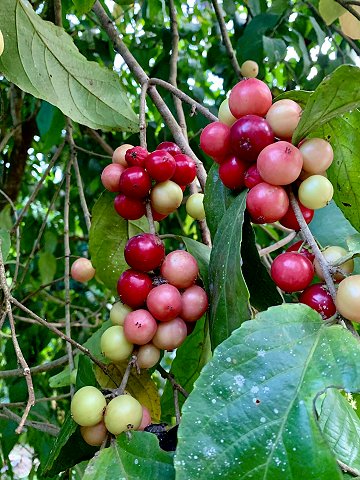
|
|
Indian plum (Flacourtia jangomas).
Leaves and
fruits.
|
Indian plum - Flacourtia jangomas
Flacourtia jangomas, or also known as the Indian coffee plum, Indian plum, Runealma Plum or scramberry, is a lowland and mountain rain forest tree in the family Salicaceae. It was once placed in the Flacourtiaceae family. It is widely cultivated in Southeast and East Asia, but also in Tropical America, for its edible fruit,
and has escaped cultivation in a number of places. Its wild origin is unknown but is speculated to be tropical Asia, *most perhaps India.
Genus Flacourtia was named after Etienne de Flacourt, former governor of Madagascar (1607-1660), and was placed in the now defunct family Flacourtiaceae.
Flacourtia jangomas is a small, deciduous shrub or tree that grows to a height of 6-10m. Trunk and branches are commonly thornless in old trees, but densely beset with simple or branched, blunt woody thorns when younger. Bark is light-brown to copper-red with a flaky texture and the leaves are light green and narrow ovate in shape. The leaves and roots contain tannin.
The native range of this species is uncertain as individuals have not been found in the wild. However, it is thought to have originated from India. (Van Steenis, 1954). It has naturalized in areas such as Hawaii, New Caledonia, Cook Islands, La Reunion and Australia.
This plant is native to Southeast Asia, very common in the Southern India and is of culinary and medical importance, especially in Kerala.
It is a hardy plant that can take full sun or semi-shade and requires regular to moderate water.
The plant is dioecious, having separate reproductive organs on different individuals, producing either male or female flowers.
It produces small white to whitish green fragrant flowers.
The relatively juicy fruits are rounded pink to dark red and about 1.5–2.5
cm wide. The flesh is firm, greenish yellow, dark red when
ripe. These fruits are edible and are often used in jams, as well as for their ethnomedical uses.
Flacourtia jangomas fruits are widely eaten around South Asia, both raw and cooked. They are noted for their mild sour and tangy taste. The fruit is usually rubbed between the palms of the hands prior to eating it in order to reduce the astringency.
The fruits are pickled, salt-dried or cooked in Indian curries. They can also be blended into juices or made into jams and marmalades which are immensely popular in Southern India. Commercially produced coffee plum jams and pickles are exported across the world by various companies, mainly from Kerala.
Young shoots are edible.
They have an acid flavour. In Indonesia, young shoots are eaten.
Health wise, Flacourtia jangomas is packed with many vitamins, minerals, and electrolytes that are essential for a healthy diet. It has significant amounts of vitamin A and C and notable levels of minerals such as calcium, iron, and dietary fiber. In addition to the vitamins and minerals, Flacourtia jangomas has a high content of antioxidants, said to reduce the risk of chronic diseases such as cancer, heart disease, and diabetes.
In South Asian folkloric medicine, the fruits and leaves of Indian coffee plum are used against diarrhea. Dried leaves are reportedly effective for bronchitis and roots are said to suppress toothache. The bark of Flacourtia jangomas has various antifungal and antibacterial constituents which makes it an important ingredient for a few Ayurvedic drugs. Ground bark paste is also used for curing many common ailments in the tribal settlements of Western Ghat.
Fruits used in bilious conditions, for treatment of bleeding gums, toothaches, diabetes, piles. Also used for jaundice and enlarged spleen.
Used for asthma, pre- and post-natal blood purification. Bark used for intermittent fever. Bark infusion used as gargle to alleviate hoarseness.
Leaves are astringent and stomachic. In Malaysia, juice squeezed from roots used to treat herpes infections.
In Bangladesh, fruit endosperm is consumed to maintain kidney function. Fruit eaten as remedy for fish thorn in the throat.
Walking sticks are made from the branches.
The
wood is hard, closed grained, durable, and polishes well. used for making small utensils and agricultural
tools. The wood is sometimes harvested for lumber in the Indian states of
Tamil Nadu, Kerala and Karnataka. It is often used as a cheaper alternative to
Teak and other expensive wood.
Source:
https://en.wikipedia.org/wiki/Flacourtia_jangomas
https://tropical.theferns.info/viewtropical.php?id=Flacourtia+jangomas
http://www.stuartxchange.org/Seriales
https://toptropicals.com/catalog/uid/flacourtia_jangomas.htm
